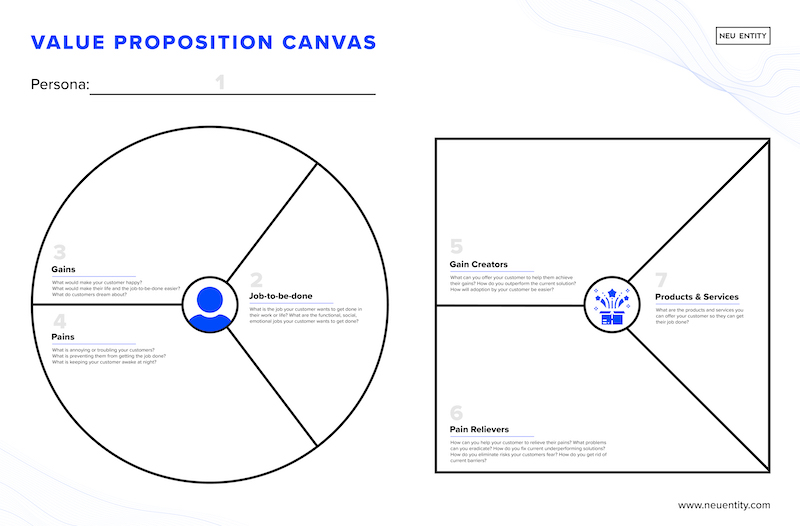There are several methods of developing a value proposition, but we like the Value Proposition Canvas Template outlined by Alex Osterwalder.
We’ve adapted it to help you understand your customer and test your ideas with them.
What is Value Proposition Canvas?
The Value Proposition Canvas is a tool designed to help businesses create products or services that meet their customers’ needs. It consists of two main parts: the Customer Profile and the Value Map.
The Customer Profile helps you identify your customers’ Jobs-to-be-Done, their pains, and gains. Jobs-to-be-Done are the tasks or problems your customers are trying to solve with your product or service. Pains are the negative emotions they feel while trying to get those jobs done, and gains are the positive outcomes they expect from solving their problems.
The Value Map helps you define how your product or service addresses your customers’ pains and gains. It consists of the Gain Creators, the features that create gains for your customers, and the Pain Relievers, the features that alleviate their pains.
What is Value Proposition Canvas Template?
The Value Proposition Canvas Template is a visual tool used to create and analyze a value proposition for a product or service.
It is an extension of the Business Model Canvas, developed by Alexander Osterwalder and Yves Pigneur, and is designed to help businesses understand their customers’ needs, pain points, and desired gains while crafting a compelling value proposition.
Value Proposition Canvas Free Template
You can Download Free Value Proposition Canvas Template here

How to use Value Proposition Canvas and Examples
Here’s a step-by-step guide on how to use the Value Proposition Canvas Template:
1. Persona
Before creating any value proposition, you need to have a clear understanding of your target audience. Start by creating a fictional character, or persona, that represents your ideal customer. Give your persona a name and describe their demographics, interests, and habits.
For instance, if you’re creating a value proposition for a mobile fitness app, your persona might be someone like John, a 30-year-old office worker who wants to stay fit but has a busy schedule.
2. Jobs to be done
Next, consider the jobs-to-be-done that your persona might be trying to accomplish. This involves identifying the specific tasks or goals that your customer wants to achieve, rather than focusing solely on their demographics or purchasing habits.
For example, John’s jobs-to-be-done might include “finding time for exercise” or “tracking progress towards fitness goals.”
3. Gains
Once you understand your customer’s jobs-to-be-done, think about the gains they might be seeking from a product or service like yours. These are the positive outcomes that your customer hopes to achieve by using your product or service.
For John, potential gains might include improved physical health, increased energy, and better self-confidence.
4. Pain points
Of course, there are also pain points or problems that your customer might be experiencing while trying to achieve their jobs-to-be-done. These are the negative emotions or barriers that stand in the way of their goals.
For John, pain points might include feeling too tired after work to exercise, or not having a clear plan for reaching his fitness goals.
5. Gain creator
This section is all about defining what your product or service does to create a gain for the consumer. Consider whether there are any features that can be removed or new ones that could be added to better deliver on the gains your customers are seeking.
For example, the mobile fitness app might include a personalized workout plan generator to help John reach his goals more efficiently.
6. Pain relievers
For each job-to-be-done, you’ll want to list all pain relievers – in other words, the ways your product or service can help alleviate the negative emotions associated with that job-to-be-done.
For John, pain relievers might include reminders to take breaks and stretch during the workday, or the ability to track progress towards fitness goals to maintain motivation.
7. Products/services
This section is where you’ll identify the specific product or service that you’ll offer to help address the pain points and enable the gains of your potential customers. Consider how your product or service can deliver on the gain creators and pain relievers you’ve identified.
For example, the mobile fitness app might offer a range of customizable workout plans tailored to John’s preferences and fitness level.
8. Value proposition hypotheses
Finally, use all the information you’ve gathered to create hypotheses about how your product or service will solve your customer’s problems, provide desired gains, and enhance their lives overall. Consider which value propositions are most desirable, feasible, and viable for both your customers and your business.
For example, By using our mobile fitness app, John will achieve improved physical health, increased energy, and better self-confidence. Our app offers personalized workout plans designed to help him reach his fitness goals efficiently, and pain relievers such as progress tracking to maintain motivation and reminders to take breaks and stretch during the workday.
By following the steps outlined in the Value Proposition Canvas Template, you’ll be able to better understand your customers’ needs and create a product or service that truly delivers value. Remember to test your hypotheses with your target audience to ensure you’re on the right track.
Final Thought
The Value Proposition Canvas is a great tool for any business or product team. You can analyze your strategies and improve your products. It helps you to understand your market, customers, and product capabilities. It encourages a bottom-up method that is scalable and repeatable. And finally, it helps you to find your unique selling proposition and customer value.
Related Articles
Let’s Talk!
If what you see here is relevant for you and can help you grow your business or organisation, we’d love to discuss further with you. Drop us a message or schedule an appointment with us.




